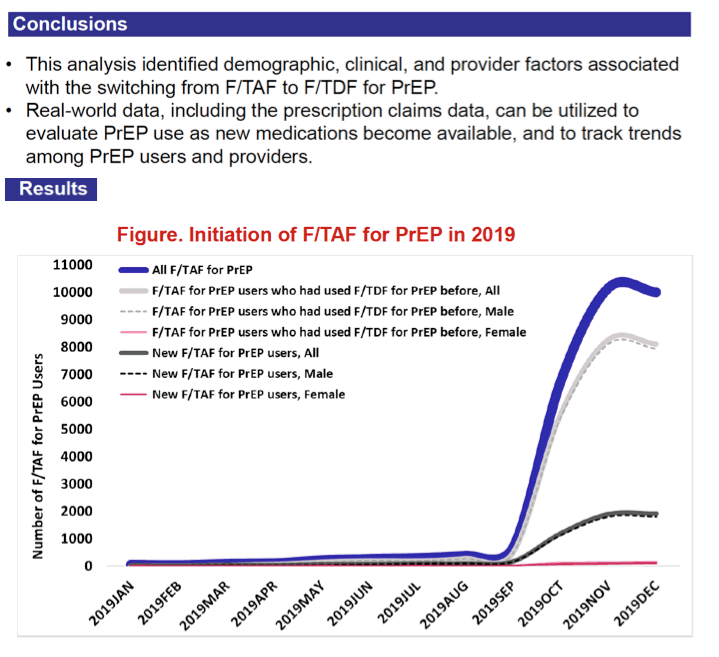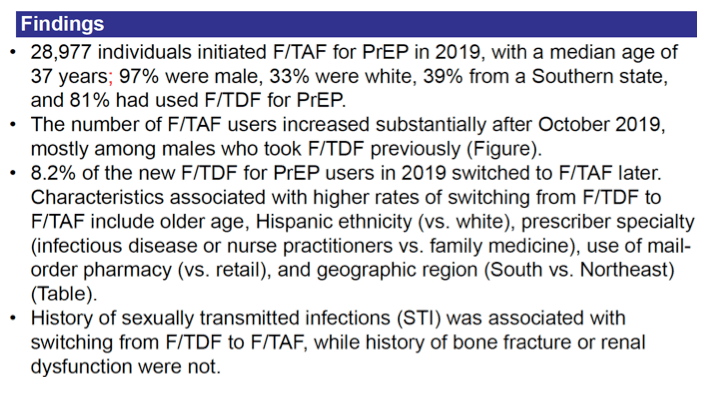 |
 |
 |
| |
Switching from F/TDF to F/TAF for HIV
Pre-exposure Prophylaxis: An Analysis of the Real-World Data
|
| |
| |
Presented at the HIVR4P, Virtual, 27-28 January and 3-4 February 2021
Li Tao, Valentina Shvachko, Christoph Carter, Moupali Das, and David Magnuson
Gilead Sciences, Inc. Foster City, CA 94404
Abstract
BACKGROUND:
F/TAF (emtricitabine/tenofovir alafenamide fumarate) for HIV pre-exposure prophylaxis (PrEP) demonstrated non-inferior efficacy compared to F/TDF (emtricitabine/tenofovir disoproxil fumarate) with less impact on renal function and bone mineral density. It was approved for PrEP in the United States (US) on October 3rd, 2019. This study assessed the number of people taking F/TAF or F/TDF for PrEP in 2019 and the factors associated with switching from F/TDF to F/TAF.
METHODS:
We identified 28,977 HIV-1 negative individuals who initiated F/TAF and 76,361 who initiated F/TDF for PrEP between January 1, 2019 and December 31, 2019 from a de-identified prescription claims database in the US. We used Cox regressions adjusting for multiple demographic and clinical characteristics to estimate the switching rate from F/TDF to F/TAF.
RESULTS:
At initiation the 28,977 F/TAF for PrEP users had a median age of 37 years of age (interquartile range 29-49), 97% were males, and 81% had used F/TDF previously. The number of F/TAF users increased substantially after October 2019, mostly among males who previously took F/TDF. Multivariate analysis showed that among all 76,361 individuals who initiated F/TDF for PrEP use in 2019, older age, male sex, and Hispanic ethnicity were associated with higher rates of switching to F/TAF for PrEP. Similarly, we found higher rates of switching to F/TAF if the F/TDF for PrEP was prescribed by internal medicine (IM), infectious disease (ID) physicians or nurse practitioners (NP) compared with family medicine (FM) physicians, and among individuals utilizing mail-order prescription services compared with retail pharmacies. Finally, history of sexually transmitted infections was associated with switching from F/TDF to F/TAF, while history of bone fracture or renal dysfunction were not.
CONCLUSIONS:
In 2019, ∼29,000 individuals took F/TAF for PrEP. Characteristics most strongly associated with switching to F/TAF were prescriber specialty (IM, ID or NP vs. FM), older age, use of mail-order pharmacy, geographic region (South vs. Northeast), and Hispanic ethnicity. We observed no associations with bone fracture and renal dysfunction. This real-world data analysis demonstrates how prescription claims data can be utilized to evaluate PrEP use as new medications become available, and to track trends among PrEP users and providers.




|
| |
|
 |
 |
|
|